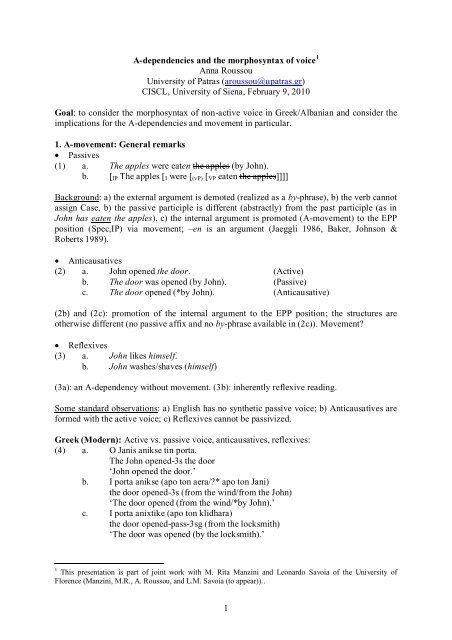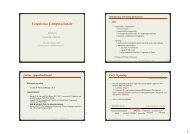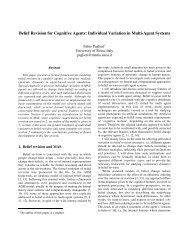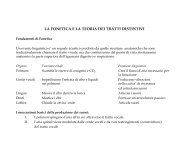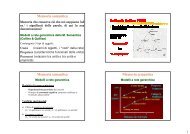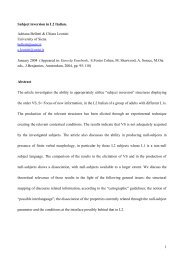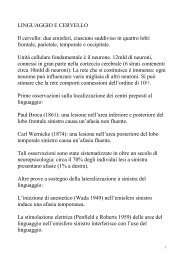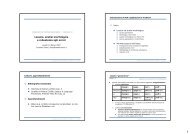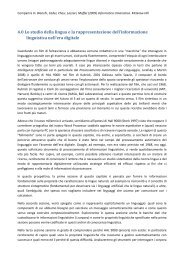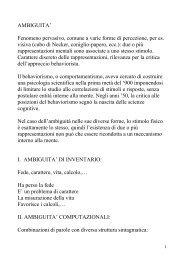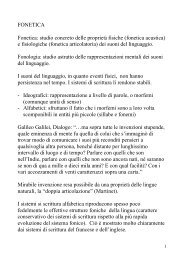Verbal morphology in Greek: the 'passive'
Verbal morphology in Greek: the 'passive'
Verbal morphology in Greek: the 'passive'
Create successful ePaper yourself
Turn your PDF publications into a flip-book with our unique Google optimized e-Paper software.
A-dependencies and <strong>the</strong> morphosyntax of voice 1<br />
Anna Roussou<br />
University of Patras (aroussou@upatras.gr)<br />
CISCL, University of Siena, February 9, 2010<br />
Goal: to consider <strong>the</strong> morphosyntax of non-active voice <strong>in</strong> <strong>Greek</strong>/Albanian and consider <strong>the</strong><br />
implications for <strong>the</strong> A-dependencies and movement <strong>in</strong> particular.<br />
1. A-movement: General remarks<br />
Passives<br />
(1) a. The apples were eaten <strong>the</strong> apples (by John).<br />
b. [ IP The apples [ I were [ (vP) [ VP eaten <strong>the</strong> apples]]]]<br />
Background: a) <strong>the</strong> external argument is demoted (realized as a by-phrase), b) <strong>the</strong> verb cannot<br />
assign Case, b) <strong>the</strong> passive participle is different (abstractly) from <strong>the</strong> past participle (as <strong>in</strong><br />
John has eaten <strong>the</strong> apples), c) <strong>the</strong> <strong>in</strong>ternal argument is promoted (A-movement) to <strong>the</strong> EPP<br />
position (Spec,IP) via movement; –en is an argument (Jaeggli 1986, Baker, Johnson &<br />
Roberts 1989).<br />
Anticausatives<br />
(2) a. John opened <strong>the</strong> door. (Active)<br />
b. The door was opened (by John). (Passive)<br />
c. The door opened (*by John). (Anticausative)<br />
(2b) and (2c): promotion of <strong>the</strong> <strong>in</strong>ternal argument to <strong>the</strong> EPP position; <strong>the</strong> structures are<br />
o<strong>the</strong>rwise different (no passive affix and no by-phrase available <strong>in</strong> (2c)). Movement?<br />
Reflexives<br />
(3) a. John likes himself.<br />
b. John washes/shaves (himself)<br />
(3a): an A-dependency without movement. (3b): <strong>in</strong>herently reflexive read<strong>in</strong>g.<br />
Some standard observations: a) English has no syn<strong>the</strong>tic passive voice; b) Anticausatives are<br />
formed with <strong>the</strong> active voice; c) Reflexives cannot be passivized.<br />
<strong>Greek</strong> (Modern): Active vs. passive voice, anticausatives, reflexives:<br />
(4) a. O Janis anikse t<strong>in</strong> porta.<br />
The John opened-3s <strong>the</strong> door<br />
„John opened <strong>the</strong> door.‟<br />
b. I porta anikse (apo ton aera/?* apo ton Jani)<br />
<strong>the</strong> door opened-3s (from <strong>the</strong> w<strong>in</strong>d/from <strong>the</strong> John)<br />
„The door opened (from <strong>the</strong> w<strong>in</strong>d/*by John).‟<br />
c. I porta anixtike (apo ton klidhara)<br />
<strong>the</strong> door opened-pass-3sg (from <strong>the</strong> locksmith)<br />
„The door was opened (by <strong>the</strong> locksmith).‟<br />
1 This presentation is part of jo<strong>in</strong>t work with M. Rita Manz<strong>in</strong>i and Leonardo Savoia of <strong>the</strong> University of<br />
Florence (Manz<strong>in</strong>i, M.R., A. Roussou, and L.M. Savoia (to appear))..<br />
1
(5) a. (o Janis) plenete/ plithike<br />
<strong>the</strong> John wash-3s.pass/washed-pass-3sg<br />
„John is (be<strong>in</strong>g) washed/ John was washed‟<br />
„John washes (himself)/ John washed (himself)‟<br />
b. To aftok<strong>in</strong>ito plithike (apo ti vroxi/apo ton Jani).<br />
<strong>the</strong> car washed-pass-3s (from <strong>the</strong> ra<strong>in</strong>/from <strong>the</strong> John)<br />
„The car got washed (with <strong>the</strong> ra<strong>in</strong>)/ was washed (by John)‟<br />
<br />
<br />
<br />
Three possible read<strong>in</strong>gs:<br />
a) passive, b) reflexive („middle‟), c) anticausative. The passive read<strong>in</strong>g arises <strong>in</strong> all cases<br />
(deponents aside); <strong>the</strong> reflexive seems to require an animate subject; <strong>the</strong> anticausative is<br />
not tied to voice <strong>morphology</strong>. Make use of <strong>the</strong> term non-active voice (NACT).<br />
Voice <strong>morphology</strong>:<br />
active vs. non-active with fur<strong>the</strong>r variation <strong>in</strong> <strong>the</strong> realization of <strong>the</strong> latter.<br />
Each NACT <strong>morphology</strong> is compatible with any of <strong>the</strong> three mean<strong>in</strong>gs and vice-versa.<br />
Some questions that arise<br />
What do <strong>the</strong>se data imply for <strong>the</strong> standard A-movement approach, assum<strong>in</strong>g that <strong>the</strong> basic<br />
property of all three read<strong>in</strong>gs is <strong>the</strong> association of an <strong>in</strong>ternal argument with <strong>the</strong> EPP<br />
position?<br />
What is <strong>the</strong> relationship between syntax and <strong>morphology</strong> and between morphosyntax and<br />
LF?<br />
Is mean<strong>in</strong>g built <strong>in</strong>side syntax, or is it syntax that constra<strong>in</strong>s mean<strong>in</strong>g?<br />
2. The empirical evidence I: <strong>Greek</strong><br />
I. Morphology<br />
The morphologies: (a) examples = NACT voice, (b) examples = active voice<br />
Present (imperfective)<br />
(6) a. plen- ome/ ese/ ete/ omaste / osaste/ onde<br />
wash 1sg 2sg 3sg 1pl 2pl 3pl<br />
„I am (be<strong>in</strong>g) washed‟, etc.<br />
b. plen- o/ is/ i/ ume/ ete/ un(e)<br />
wash 1sg 2sg 3sg 1pl 2pl 3pl<br />
„I am wash<strong>in</strong>g/I wash (someone)‟ etc.<br />
Past imperfective<br />
(7) a. plen- omun/ osun/ otan/ omastan/ ostastan/ ondan<br />
wash 1sg 2sg 3sg 1pl 2pl 3pl<br />
„I was be<strong>in</strong>g washed‟ etc.<br />
b. (e)plen- a/ es/ e/ ame/ ate/ an<br />
wash(ed) 1sg 2sg 3sg 1pl 2pl 3pl<br />
„I was wash<strong>in</strong>g (somebody)‟ etc.<br />
Perfective aspect: <strong>the</strong> affix –th (or its allophones) and active voice <strong>in</strong>flections:<br />
Past perfective<br />
(8) a. pli- th- ik- a/ es/ e/ ame/ ate/ an<br />
wash NACT past 1sg 2sg 2sg 1pl 2pl 3pl<br />
„I was washed‟ etc.<br />
b. (e)pl<strong>in</strong>- a/ es/ e/ ame/ ate/ an<br />
wash 1sg 2sg 3sg 1pl 2pl 3pl<br />
2
„I washed (someone)‟ etc.<br />
Perfective „dependent‟ forms (non-past; see Holton et al 1999)<br />
(9) a. pli- th- o/ is/ i/ ume/ ete/ un<br />
wash NACT 1sg 2sg 3sg 1pl 2pl 3pl<br />
„I am washed‟ etc.<br />
b. pl<strong>in</strong>- o/ is/ i/ ume/ ete/ un<br />
wash 1sg 2sg 3sg 1pl 2pl 3pl<br />
„I wash (somebody)‟ etc.<br />
(i) The dependent form has to be preceded by a particle (na, tha, as), a free relative pronoun,<br />
certa<strong>in</strong> temporal conjunctions or adverbs; (ii) Perfective aspect here is marked through vowel<br />
rais<strong>in</strong>g – <strong>in</strong> o<strong>the</strong>r cases it is marked by <strong>the</strong> affix –s follow<strong>in</strong>g <strong>the</strong> stem (akuo ~ aku-s-o<br />
„hear‟), by vowel rais<strong>in</strong>g and –s (dh<strong>in</strong>o ~ dhoso „give‟), by suppletion (troo ~ fao „eat‟).<br />
Ralli (2005): th- and thik- are allomorphs; Philippaki-Warburton (1973): th- is <strong>the</strong> voice affix,<br />
-ik is past tense (see also Spyropoulos & Revithiadou 2009 for <strong>the</strong> latter).<br />
<br />
The affix th- and specialized NACT <strong>in</strong>flection are mutually excluded, i.e. *plith-ome,<br />
*plith-omun; Ralli (2005) <strong>the</strong>re is a constra<strong>in</strong>t that blocks <strong>the</strong> co-occurrence of two<br />
affixes with <strong>the</strong> same feature (here NACT voice).<br />
Perfect:<br />
The verb exo and <strong>the</strong> „participle‟ <strong>in</strong> –i (Hesse 1980, Joseph 1983); voice is marked on <strong>the</strong><br />
participle (which is syncretic with 3 rd s<strong>in</strong>gular perfective „dependent‟):<br />
(10) a. ex -o/ -is/ -i/ -ume/ -ete/ -un pli-th-i.<br />
have 1sg etc. wash- NACT -Infl<br />
„I have been washed‟<br />
b. ex -o/ -is/ -i/ -ume/ -ete/ -un pl<strong>in</strong>-i<br />
have 1sg etc. wash-Infl<br />
„I have washed (somebody)‟<br />
Formations with <strong>the</strong> <strong>in</strong>flected participle –menos are also available (Veloudis 1991); <strong>in</strong> this<br />
case voice is marked through auxiliary choice, i.e. ime „be‟ for NACT, exo „have‟ for active:<br />
(11) a. ime plimenos/plimeni/plimeno<br />
am washed-sg.masc/fem/neut<br />
„I am washed.‟<br />
b. (ta) exo plimena (ta ruxa)<br />
<strong>the</strong>m have-1sg washed.pl-neut <strong>the</strong> clo<strong>the</strong>s<br />
„I have <strong>the</strong> clo<strong>the</strong>s washed.<br />
II. Interpretations<br />
Three possible <strong>in</strong>terpretations associated with NACT voice, depend<strong>in</strong>g on <strong>the</strong> predicate, <strong>the</strong><br />
subject, <strong>the</strong> presence/absence of a by-phrase, etc.:<br />
(12) a. O Janis trip-j-ete.<br />
<strong>the</strong> John prick-3sg.NACT<br />
b. O Janis tripithike /exi thripithi<br />
<strong>the</strong> John pricked-NACT-past-3sg has pricked-NACT-3sg<br />
3
(i)<br />
(ii)<br />
(iii)<br />
Passive: John is be<strong>in</strong>g/was pricked (by <strong>the</strong> doctor).<br />
Reflexive: John is prick<strong>in</strong>g/pricked himself.<br />
Anticausative: John is be<strong>in</strong>g/was pricked (accidentally) with <strong>the</strong> needle.<br />
All NACT morphologies (specialized <strong>in</strong>flection and th-formations) give rise to all read<strong>in</strong>gs;<br />
[See also Manney 2000, Tsimpli 2005, 2006, Alexiadou & Anagnostopoulou 2004].<br />
III. The pattern and <strong>the</strong> questions that arise<br />
Specialized agreement vs. active agreement with th-.<br />
The split is regulated by aspect (perfective).<br />
What are <strong>the</strong> properties of th- and specialized agreement, such that <strong>the</strong> presence of <strong>the</strong><br />
former excludes <strong>the</strong> latter and vice versa? (cf. *di-th-ome).<br />
How do <strong>the</strong>se morphological realizations correlate with syntax?<br />
How do <strong>the</strong>se morphologies correlate with <strong>the</strong> English passive affix –en (if <strong>the</strong>y do)?<br />
3. The empirical evidence II: Albanian (Standard and dialects)<br />
I. Morphology<br />
Data from Gjirokastër (a Tosk variety, essentially <strong>the</strong> Standard) and from Shkodër (a Geg<br />
variety) [IPA transcription used] – (h)= <strong>the</strong> NACT affix. 2<br />
Present imperfective<br />
(13) Gjirokastër<br />
a. la- (h)- m/ / t/ mi/ ni/ n<br />
wash NACT 1sg 2sg 3sg 1pl 2pl 3pl<br />
„I am be<strong>in</strong>g washed‟ etc.<br />
b. la- i/ n/ n/ im/ ni/ <strong>in</strong><br />
wash 1sg 2sg 3sg 1pl 2pl 3pl<br />
„I wash (someth<strong>in</strong>g)‟ etc.<br />
a‟. vi- (h)- m/ / t/ mi/ ni/ n<br />
dress NACT 1sg 2sg 3sg 1pl 2pl 3pl<br />
„I am be<strong>in</strong>g dressed‟ etc.<br />
b‟. v -/ -/ -/ im/ ni/ <strong>in</strong><br />
dress 1sg 2sg 3sg 1pl 2pl 3pl<br />
„I dress (somebody)‟ etc.<br />
(14) Shkodër<br />
a. l- - m/ / t/ na/ ni/ n<br />
wash NACT 1sg 2sg 3sg 1pl 2pl 3pl<br />
„I am be<strong>in</strong>g washed‟ etc.<br />
b. l- i/ n/ n/ im/ ni/ <strong>in</strong><br />
wash 1sg 2sg 3sg 1pl 2pl 3pl<br />
„I wash (someth<strong>in</strong>g)‟ etc.<br />
a‟. ve- - m/ / t/ na/ ni/ n<br />
dress NACT 1sg 2sg 3sg 1pl 2pl 3pl<br />
„I am be<strong>in</strong>g dressed‟ etc.<br />
2 For more data see Manz<strong>in</strong>i & Savoia (2008).<br />
4
‟. ve- i<br />
ve:<br />
ve:<br />
ve- im<br />
ve- ni<br />
ve- <strong>in</strong><br />
dress 1sg etc.<br />
„I dress (somebody)‟ etc.<br />
The person <strong>in</strong>flections <strong>in</strong> <strong>the</strong> (a) and (a‟) examples are specialized for <strong>the</strong> NACT voice.<br />
Perfective past (aorist)<br />
(15) Gjirokastër<br />
a. u la- it- a/ / -/ m/ t/ n<br />
NACT wash PAST 1sg 2sg 3sg 1pl 2pl 3pl<br />
„I was washed‟ etc.<br />
b. la- it- i<br />
it wash PAST 3sg<br />
„He washed it‟<br />
a‟. u v- a/ / -/ m/ t/ n<br />
NACT dress 1sg 2sg 3sg 1pl 2pl 3pl<br />
„I was dressed‟ etc.<br />
b‟. v- i<br />
him dress 3sg<br />
„He dressed him‟<br />
(16) Shkodër<br />
a. u l- v- a<br />
u l- v- <br />
u l:<br />
u l- m<br />
u l:- t<br />
u l- n<br />
NACT wash PAST 1sg etc.<br />
„I was washed‟ etc.<br />
b. la- u<br />
it wash 3sg<br />
„He washed it‟<br />
a‟. u ve- a<br />
u ve- <br />
u v<br />
u ve- m<br />
u ve- t<br />
u ve- n<br />
NACT dress 1sg etc.<br />
„I was dressed‟ etc.<br />
5
‟. ve- i<br />
it dress 3sg<br />
„He dressed him‟<br />
<br />
The person/agreement <strong>in</strong>flections are those of <strong>the</strong> active voice; NACT voice is formed with<br />
<strong>the</strong> clitic u – similar to Romance si/se (but <strong>the</strong> same for all persons <strong>in</strong> both numbers).<br />
Substitut<strong>in</strong>g u for <strong>the</strong> object clitic gives rise to an active (transitive) syntax.<br />
The split <strong>in</strong> <strong>the</strong> realization of voice seems to be regulated by aspect, as <strong>in</strong> <strong>Greek</strong>. But:<br />
Past imperfective:<br />
(17) Gjirokastër<br />
a. la- (h)- - a/ / -/ im/ it/ <strong>in</strong><br />
wash NACT past 1sg 2sg 3sg 1pl 2pl 3pl<br />
„I was be<strong>in</strong>g washed‟ etc.<br />
b. la- j- a<br />
j- <br />
n- t<br />
n- im<br />
n- it<br />
n- <strong>in</strong><br />
it wash past 1sg etc<br />
„I was wash<strong>in</strong>g it‟ etc.<br />
a‟. vi- - - a/ / -/ im/ it/ <strong>in</strong><br />
dress NACT past 1sg 2sg 3sg 1pl 2pl 3pl<br />
„I was be<strong>in</strong>g dressed‟ etc.<br />
b‟. vi- j- a<br />
j- <br />
t<br />
n- im<br />
n- it<br />
n- <strong>in</strong><br />
dress Past 1sg etc.<br />
„I was dress<strong>in</strong>g (somebody)‟ etc.<br />
(18) Shkodër<br />
a. u / l- - a<br />
- <br />
t<br />
- im<br />
- it<br />
- <strong>in</strong><br />
NACT /it wash past.impf 1sg etc.<br />
„I was be<strong>in</strong>g washed/ I was wash<strong>in</strong>g it‟ etc.<br />
b. u/ ve- - a<br />
- <br />
t<br />
6
- im<br />
- it<br />
- <strong>in</strong><br />
NACT /him dress past.impf 1sg etc.<br />
„I was be<strong>in</strong>g dressed/ I was dress<strong>in</strong>g it‟ etc.<br />
<br />
In <strong>the</strong> Tosk dialects <strong>the</strong> split <strong>in</strong> <strong>the</strong> realization of NACT voice is conditioned by<br />
(perfective) aspect, while <strong>in</strong> <strong>the</strong> Geg varieties it is conditioned by tense (past).<br />
Perfect<br />
Voice is marked through auxiliary choice: jam „be‟ for NACT, and kam „have‟ for active, both<br />
followed by <strong>the</strong> same participle.<br />
(19) Gjirokastër<br />
a. t la- it- ur<br />
is wash prf prt<br />
„He has been washed‟<br />
b. ka la- it- ur<br />
it has wash prf prt<br />
„He has washed it‟<br />
a‟. t v- ur<br />
is dress prt<br />
„He has been dressed‟<br />
b‟. ka v- ur<br />
him has dress prt<br />
„He has washed him‟<br />
(20) Shkodër<br />
a. l:/ ve:<br />
is washed/ dressed<br />
„He has been washed/dressed‟<br />
b. k l:/ ve:<br />
him has washed/ dressed<br />
„He has washed/ dressed him‟<br />
[For more details on <strong>the</strong> participial <strong>morphology</strong>, see Manz<strong>in</strong>i & Savoia 2007].<br />
Shkodër (Geg) uses <strong>the</strong> bare form of <strong>the</strong> verb, which co<strong>in</strong>cides with <strong>the</strong> 2 nd and 3 rd person of<br />
<strong>the</strong> present, while Gjirokastër (Tosk) has a dist<strong>in</strong>ct participial form (<strong>the</strong> –r participle).<br />
Arbëresh dialects (of <strong>the</strong> Tosk type, spoken <strong>in</strong> Sou<strong>the</strong>rn Italy): Portocannone has <strong>the</strong> NACT<br />
affix -x- also <strong>in</strong> <strong>the</strong> perfective past <strong>in</strong> (21c) along with <strong>the</strong> u clitic (<strong>the</strong> morphological<br />
constra<strong>in</strong>t of Ralli (2005) for <strong>Greek</strong> cannot obviously hold here).<br />
(21) Portocannone<br />
a. la- x- m/ / t/ mi/ ni/ n<br />
wash NACT 1sg/ 2sg 3sg 1pl 2pl 3pl<br />
„I am be<strong>in</strong>g washed‟<br />
b. la- x- - a/ / i/ m/ t/ n<br />
wash.up NACT impf 1sg/ 2sg 3sg 1pl 2pl 3pl<br />
„I was be<strong>in</strong>g washed‟ etc.<br />
7
c. u la- x- t/ / -/ m/ t/ n<br />
NACT wash NACT 1sg/ 2sg 3sg 1pl 2pl 3pl<br />
„I was washed‟ etc.<br />
d. la- v- a/ / i/ m/ t/ n<br />
it wash past 1sg etc.<br />
„I washed it‟ etc.<br />
Perfect<br />
(22) a. at k<strong>in</strong> u la- x- ur<br />
<strong>the</strong>y had NACT wash-NACT-prt<br />
„They had washed <strong>the</strong>mselves‟<br />
b. at k<strong>in</strong> la- it- ur<br />
<strong>the</strong>y had it wash perf prt<br />
„They had washed it‟<br />
As <strong>in</strong> <strong>Greek</strong>, voice is not dist<strong>in</strong>guished by auxiliary choice but by <strong>the</strong> ma<strong>in</strong> verb/participle.<br />
II. Interpretations<br />
Passive, reflexive, anticausative (as <strong>in</strong> <strong>Greek</strong>), plus <strong>the</strong> impersonal (cf. si). All read<strong>in</strong>gs<br />
available with all morphologies:<br />
(23) Gjirokastër<br />
a. zu- (h)- t b. zu- (h)- <br />
wake NACT 3sg<br />
wake NACT past<br />
„He wakes up‟<br />
„He was wak<strong>in</strong>g up‟<br />
c. u z- it d. t zu- a<br />
NACT wake prf he.is wake prt<br />
„He woke up‟<br />
„He has woken up‟<br />
(24) Shkodër<br />
a. to- h- t b. u to- t<br />
wake NACT 3sg<br />
NACT wake 3sg<br />
„He wakes up‟<br />
„He was wak<strong>in</strong>g up‟<br />
c. u tu: d. t tu:<br />
NACT woke he.is woken<br />
„He woke up‟<br />
„He has woken up‟<br />
(i)<br />
<br />
Passive: He is/was/has been woken up by <strong>the</strong> o<strong>the</strong>rs.<br />
Reflexive: He is wak<strong>in</strong>g/woke/has woken himself up.<br />
Anticausative: He is wak<strong>in</strong>g/woke/has woken up (accidentally).<br />
The impersonal read<strong>in</strong>g („one‟) is also available (so it can attach to <strong>in</strong>transitive<br />
unergatives; no by-phrase is available):<br />
(25) Gjirokastër<br />
a. ati fl- (h)- t mi<br />
<strong>the</strong>re sleep- NACT -3sg well<br />
„There one sleeps well‟<br />
8
. ati u fit mi<br />
<strong>the</strong>re NACT slept well<br />
„There one slept well‟<br />
Also with unaccusatives:<br />
(26) Gjirokastër<br />
a. ga ati dil- - t<br />
from <strong>the</strong>re exit- NACT -3sg<br />
„One exits from <strong>the</strong>re‟<br />
a‟. ai del<br />
he exits<br />
„He exits‟<br />
b. ga ati u d<br />
from <strong>the</strong>re NACT exited<br />
„One exited from <strong>the</strong>re‟<br />
b‟. ai d- i<br />
he exited-3sg<br />
„He exited‟<br />
c. ga ati t dal mi<br />
from <strong>the</strong>re it.is exited well<br />
„One has exited well from <strong>the</strong>re‟<br />
c‟. ka dal<br />
he.has gone<br />
„He has exited‟<br />
III. Questions<br />
The ones raised for <strong>Greek</strong>, plus<br />
Why is aux jam <strong>in</strong>compatible with <strong>the</strong> clitic u?<br />
Summariz<strong>in</strong>g <strong>the</strong> picture<br />
(27) The patterns<br />
NACT specialized <strong>in</strong>flection u/-th and ACT <strong>in</strong>flection Perfect tenses<br />
MG Imperfective (present, past) Perfective (present, past) exo+ V-th-i (perfective)<br />
Tosk Imperfective (present, past) Perfective (past) jam+V(-it-u)r participle<br />
Geg Present Past jam+ participle =verb base<br />
Some generalizations<br />
a. Specialized NACT <strong>in</strong>flection and th-/u are <strong>in</strong>compatible.<br />
b. Auxiliary jam „be‟ u are <strong>in</strong>compatible (but kam „have‟ isn‟t; see Portocannone).<br />
4. The morphosyntax<br />
4.1. Specialized <strong>in</strong>flections<br />
<strong>Greek</strong> and Albanian are pro-drop languages. Person/agreement <strong>in</strong>flections realize <strong>the</strong> EPP<br />
feature/property (correspond<strong>in</strong>g to <strong>the</strong> external, <strong>in</strong>ternal argument, or an expletive).<br />
(28) a. (I Maria) plen-i ta ruxa.<br />
<strong>the</strong> Mary wash-3s <strong>the</strong> clo<strong>the</strong>s<br />
“Mary/she washes <strong>the</strong> clo<strong>the</strong>s.”<br />
9
. (To filo) peft-i<br />
<strong>the</strong> leaf fall-3p<br />
“The leaf/it falls.”<br />
c. Vrex-i.<br />
ra<strong>in</strong>-3S<br />
“It ra<strong>in</strong>s.”<br />
(29) Active voice <strong>in</strong>flections<br />
3<br />
<br />
plen<br />
D (=EPP)<br />
o/-is/-i/ etc.<br />
If a DP/clitic is present, <strong>the</strong>n it forms a cha<strong>in</strong> with D. The morphological structure builds on<br />
<strong>the</strong> same D category as syntax (so <strong>morphology</strong> and syntax are unified).<br />
Active person <strong>in</strong>flections nom<strong>in</strong>ative case.<br />
NACT <strong>in</strong>flections, on <strong>the</strong> o<strong>the</strong>r hand, exclude <strong>the</strong> external argument and consistently pick<br />
up <strong>the</strong> <strong>in</strong>ternal argument, thus resembl<strong>in</strong>g participial <strong>in</strong>flection <strong>in</strong> Romance, cf. Italian<br />
mangiat-a/-i (eaten-FEM.SG/PL) or arrivat-a/-i (arrived-FEM.SG/PL) (Burzio 1986)<br />
NACT <strong>in</strong>flections absolutive case.<br />
(30) a. (Ta pedhjia) plenonde.<br />
<strong>the</strong> children wash-NACT.3p<br />
“The children are be<strong>in</strong>g washed/ The children wash (<strong>the</strong>mselves).”<br />
b. (To aftok<strong>in</strong>ito) plenete.<br />
<strong>the</strong> car wash-NACT.3s<br />
“The car is be<strong>in</strong>g washed.”<br />
In (a): most salient read<strong>in</strong>gs = passive, reflexive; <strong>in</strong> (b): passive.<br />
The <strong>in</strong>ternal argument is „promoted‟ to <strong>the</strong> EPP position; see standard generative approaches.<br />
(31) a. Active b. Non-active<br />
3 3<br />
D D<br />
plen (x,y) o (x) plen (x,y) (o)me (y)<br />
In (a): <strong>the</strong> unassociated <strong>in</strong>ternal argument receives a syntactic realization. In (b): <strong>the</strong><br />
unassociated external argument is open to a number of options: i) rema<strong>in</strong> unrealized and be<br />
existentially bound, ii) form a cha<strong>in</strong> with a DP <strong>in</strong>side <strong>the</strong> by-phrase (both give rise to a<br />
passive read<strong>in</strong>g), iii) associate with <strong>the</strong> EPP argument (<strong>the</strong> reflexive read<strong>in</strong>g), or iv) receive<br />
no <strong>in</strong>terpretation (no Agent implied; <strong>the</strong> anticausative read<strong>in</strong>g). In <strong>the</strong> absence of any<br />
additional syntactic <strong>in</strong>formation all three read<strong>in</strong>gs are resolved at LF (along with <strong>the</strong> lexical<br />
properties of <strong>the</strong> predicates <strong>in</strong>volved; see partly Tsimpli 2005).<br />
<br />
Albanian has one fur<strong>the</strong>r read<strong>in</strong>g: <strong>the</strong> impersonal (see (25) and (26) above). NACT<br />
<strong>morphology</strong> can attach to unergative verbs (compatible with <strong>the</strong> idea that <strong>the</strong>y are<br />
„hidden‟ transitives, Hale & Keyser 1993). It can also attach to unaccusatives: <strong>the</strong>ir only<br />
argument is <strong>the</strong> <strong>the</strong>me; thus <strong>the</strong> passive read<strong>in</strong>g is excluded, and <strong>the</strong> impersonal is <strong>the</strong><br />
10
only available one.<br />
(32) a. Active b. Non-active<br />
3 3<br />
D D<br />
d (y) i (x) dil (y) t (y)<br />
Unaccusatives can take ei<strong>the</strong>r <strong>the</strong> active or <strong>the</strong> NACT voice (see anticausatives <strong>in</strong> <strong>Greek</strong>). But<br />
with <strong>the</strong> NACT <strong>morphology</strong>, <strong>the</strong> generic read<strong>in</strong>g arises.<br />
4.2. The u clitic and extensions for -th<br />
I. The clitic u: similar to Italian si (reflexive, impersonal) – an object clitic correspond<strong>in</strong>g to a<br />
variable (Manz<strong>in</strong>i & Savoia 2005, 2007; Chierchia 1995 on impersonal si).<br />
Benefactive/malefactive contsrtuctions (see also Kallulli, 2006).<br />
(33) Gjirokastër<br />
m/ i u i gta<br />
to.me/to.him NACT broke <strong>the</strong>.glass<br />
„The glass broke on me/him‟<br />
<br />
Two apparently conflict<strong>in</strong>g properties:<br />
a) If u is an object clitic, <strong>the</strong>n <strong>the</strong> syntactic configuration it gives rise to is transitive (at<br />
first sight <strong>in</strong>compatible with standard approaches to passivisation <strong>in</strong> terms of Case and<br />
movement for example).<br />
b) Be<strong>in</strong>g <strong>the</strong> exponent of NACT voice it is associated with an <strong>in</strong>transitivization process<br />
(passive, anticausative, reflexive). The conflict is resolved if <strong>the</strong> morphosyntax rema<strong>in</strong>s<br />
transitive, with „<strong>in</strong>transitivisation‟ be<strong>in</strong>g <strong>the</strong> result of <strong>in</strong>terpretations aris<strong>in</strong>g at LF.<br />
(34)<br />
3<br />
Q/N 3<br />
u/ I<br />
3<br />
<br />
l (x,y)<br />
D<br />
<strong>in</strong><br />
<br />
<br />
<br />
<br />
The clitic u satisfies <strong>the</strong> <strong>in</strong>ternal argument slot (y), exactly as <strong>the</strong> clitic does.<br />
Be<strong>in</strong>g a variable it has to be bound – through <strong>the</strong> D/EPP <strong>in</strong>flection (<strong>the</strong> subject). Thus <strong>the</strong><br />
<strong>in</strong>ternal argument is promoted to <strong>the</strong> subject position/<strong>in</strong>flection.<br />
An <strong>in</strong>transitive read<strong>in</strong>g through a transitive morphosyntax. The cha<strong>in</strong> between Q and D<br />
cannot be derived by movement; a representational cha<strong>in</strong> (Brody 2003).<br />
Ano<strong>the</strong>r way to view this: D b<strong>in</strong>ds <strong>the</strong> <strong>in</strong>ternal argument y (<strong>in</strong> parallel with <strong>the</strong> specialized<br />
NACT <strong>in</strong>flection). Given <strong>the</strong> active (i.e. „non-absolutive‟) nature of <strong>the</strong> D <strong>in</strong>flection, <strong>the</strong><br />
<strong>in</strong>ternal argument must also be satisfied by <strong>in</strong>dependent („accusative‟) lexical material –<br />
here <strong>the</strong> syntactic variable u. Thus <strong>the</strong> (D, u) cha<strong>in</strong> really results from <strong>the</strong> transitivity<br />
closure of (D, y) and (u, y).<br />
11
The impersonal read<strong>in</strong>g with unaccusatives<br />
(35) Shkodër<br />
3<br />
Q 3<br />
u I<br />
3<br />
D<br />
t<br />
dl (x)<br />
(34) also has some <strong>in</strong>dependently referr<strong>in</strong>g EPP argument (at least realized as <strong>the</strong> D<br />
<strong>in</strong>flection). (35) has no such property; u is bound by a generic operator. D is like an<br />
„expletive‟ argument here.<br />
II. The –th affix <strong>in</strong> <strong>Greek</strong>: it also appears with active <strong>in</strong>flection, just like u. The affix –th is<br />
<strong>the</strong> morphological counterpart of <strong>the</strong> u clitic:<br />
(36) a. Present b. Past<br />
I<br />
I<br />
3 3<br />
3 D 3 D<br />
Q o 3 I a<br />
pli (x,y) θ Q ik<br />
pli (x,y) θ<br />
<br />
<br />
The morphological structures are „transitive‟, with –th correspond<strong>in</strong>g to <strong>the</strong> realization of<br />
<strong>the</strong> <strong>in</strong>ternal argument. If th- is a variable, it is bound by <strong>the</strong> D/EPP <strong>in</strong>flection.<br />
Ralli‟s (2005) morphological constra<strong>in</strong>t is now expla<strong>in</strong>ed: both encode <strong>the</strong> assignment of<br />
<strong>the</strong> <strong>in</strong>ternal argument slot to <strong>the</strong> D/EPP argument. Same <strong>in</strong>terpretive results based on<br />
different morphosyntactic structures though: -th structures are formally transitive, while<br />
NACT <strong>in</strong>flection ones are formally <strong>in</strong>transitive.<br />
4.3 The perfect<br />
Albanian: NACT voice = auxiliary jam + participle, active voice = aux kam +participle<br />
<strong>Greek</strong>: auxiliary exo + different participles depend<strong>in</strong>g on voice.<br />
Arbëresh: like <strong>Greek</strong>.<br />
Auxiliaries have and be: possessive (transitive) and copula (rais<strong>in</strong>g); perfect tenses form<br />
bi-clausal structures (Kayne 1993, Manz<strong>in</strong>i and Savoia 2005, 2007).<br />
Kam-perfect (active voice):<br />
(37) kam laitur „I have washed him‟<br />
Gjirokastër<br />
3<br />
N 3<br />
I …….<br />
kam<br />
3<br />
I<br />
laitur (x, y)<br />
12
The object clitic = <strong>the</strong> <strong>in</strong>ternal argument (y) of <strong>the</strong> participle (cf. restructur<strong>in</strong>g).<br />
The EPP argument is realized by <strong>the</strong> matrix f<strong>in</strong>ite <strong>in</strong>flection (<strong>the</strong> embedded EPP is just a<br />
variable for <strong>the</strong> purposes of <strong>in</strong>terpretation, which is bound by <strong>the</strong> matrix one; cf. control).<br />
(38) ton exo pl<strong>in</strong>i „I have washed him‟<br />
<br />
The same structure as <strong>in</strong> (37); pl<strong>in</strong>i is a bare verb base (alternatively, -i takes its<br />
referential properties from <strong>the</strong> matrix f<strong>in</strong>ite <strong>in</strong>flection; aga<strong>in</strong> control-like).<br />
NACT voice: <strong>Greek</strong><br />
(39) exo plithi „I have been washed‟<br />
<br />
The affix –th realizes <strong>the</strong> <strong>in</strong>ternal argument which is itself a variable, bound by <strong>the</strong> EPP<br />
<strong>in</strong>side <strong>the</strong> morphological structure. S<strong>in</strong>ce –i is also a variable, it ultimately gets bound by<br />
<strong>the</strong> matrix f<strong>in</strong>ite <strong>in</strong>flection. So <strong>the</strong> cha<strong>in</strong> extends beyond <strong>the</strong> morphological level to <strong>the</strong><br />
syntactic one.<br />
(40) 3<br />
I<br />
…….<br />
exo 3<br />
I<br />
3<br />
3 D<br />
Q i<br />
pli (x,y) θ<br />
NACT voice: Albanian<br />
The auxiliary jam with a participle; jam as a rais<strong>in</strong>g verb (after Moro 1997) (cf. <strong>the</strong> difference<br />
from kam/exo „have‟ above):<br />
(41) Gjirokastër<br />
3<br />
I<br />
…….<br />
jam 3<br />
I<br />
laitur (x, y)<br />
The <strong>in</strong>ternal argument is associated with <strong>the</strong> embedded EPP and from <strong>the</strong>re with <strong>the</strong> matrix<br />
EPP, while <strong>the</strong> external argument rema<strong>in</strong>s unassociated.<br />
The same participle has an active construal when embedded under kam as <strong>in</strong> (37), but a<br />
NACT construal when embedded under jam as <strong>in</strong> (41): each construal depends on some<br />
selectional constra<strong>in</strong>t imposed by kam and/or jam.<br />
The unaccusative dal „I go out‟ has an impersonal read<strong>in</strong>g when embedded under jam, but<br />
all o<strong>the</strong>r <strong>in</strong>terpretations when embedded under kam. In <strong>the</strong> first case, <strong>the</strong> s<strong>in</strong>gle argument<br />
(<strong>the</strong>me) is assigned to <strong>the</strong> EPP position, which is a variable (due to <strong>the</strong> participle); this<br />
variable is bound by a generic operator which <strong>the</strong>n passes on <strong>the</strong> matrix EPP with which<br />
it forms a cha<strong>in</strong>:<br />
13
(42) Gjirokastër<br />
3<br />
I …..<br />
t 3<br />
I<br />
dal (x)<br />
(43) ka dal „he has exited‟: here voice, but not valency, i.e. (<strong>in</strong>)transitivity, is selected for.<br />
Jam selects for an embedded structure conta<strong>in</strong><strong>in</strong>g a certa<strong>in</strong> type of variable (generic, or<br />
existentially bound as <strong>in</strong> passives, or unassigned as <strong>in</strong> anticausatives): jam selects for a<br />
„reduced‟ argument structure <strong>in</strong> its participial complement. This also expla<strong>in</strong>s <strong>the</strong><br />
<strong>in</strong>compatibility of jam with <strong>the</strong> clitic u.<br />
Kam/exo selects for predicates with a closed argument structure, <strong>in</strong> <strong>the</strong> sense that no free<br />
variables or generically closed ones are <strong>in</strong>stantiated with<strong>in</strong> it. <strong>Greek</strong> exo: ei<strong>the</strong>r with<br />
active voice (where <strong>the</strong> argument structure closes at <strong>the</strong> syntactic level) or with –th (at <strong>the</strong><br />
morphosyntactic level).<br />
In Arbёresh varieties: kam and <strong>the</strong> clitic u.<br />
Conclusions<br />
Specialized NACT <strong>in</strong>flection conditioned by aspect or tense. When specialized <strong>in</strong>flection is<br />
not present, <strong>the</strong> person <strong>in</strong>flections are those of <strong>the</strong> active, and NACT takes <strong>the</strong> form of a<br />
clitic (Albanian u) or an affix (<strong>Greek</strong> -th). Perfect tenses fur<strong>the</strong>r show an <strong>in</strong>teraction<br />
between NACT realizations and auxiliary selection.<br />
Each morphosyntactic realization is compatible with a range of NACT <strong>in</strong>terpretations<br />
(passive, reflexive, anticausative, and impersonal <strong>in</strong> Albanian).<br />
Specialized <strong>in</strong>flection is ak<strong>in</strong> to participial agreement („absolutive‟). The clitic u and <strong>the</strong><br />
affix –th realize <strong>the</strong> <strong>in</strong>ternal argument – variables bound by <strong>the</strong> EPP slot.<br />
Morphosyntax constra<strong>in</strong>s mean<strong>in</strong>g; ambiguity is available at LF (cf. C<strong>in</strong>que & Rizzi<br />
(2008) on „syntacticization‟).<br />
Selected References<br />
Alexiadou, A. & E. Anagnostopoulou. 2004. In A. Alexiadou, E. Anagnostopoulou and M. Everaert (eds.) The Unaccusative Puzzle, 114-<br />
136. Oxford University Press: Oxford.<br />
Chierchia G. 1995. Impersonal Subjects. In E. Bach, E. Jell<strong>in</strong>ek, A. Kratz, B. H. Partee (eds.) Quantification <strong>in</strong> natural languages, Dordrect,<br />
Kluwer: 107-143.<br />
C<strong>in</strong>que, G. & L. Rizzi. 2008. The cartography of syntactic structures. CISCL Work<strong>in</strong>g Papers on Language and Cognition, vol. 2. CISCL.<br />
Kallulli, D. 2006. A unified analysis of passives, anticausatives and reflexives. In O. Bonami & P. Cabredo Hofherr (eds.) Empirical issues<br />
<strong>in</strong> formal syntax and semantics 6: 201-225.<br />
Kayne R. 1993. Toward a modular <strong>the</strong>ory of auxiliary selection. Studia L<strong>in</strong>guistica 47: 3-31.<br />
Manz<strong>in</strong>i M. R. 1986. On Italian si. In Borer H. (ed.) The Syntax of Pronom<strong>in</strong>al Clitics, Syntax and Semantics vol. 18, New York: Academic<br />
Press, 241-262.<br />
Manz<strong>in</strong>i, M.R. & L.M. Savoia. 2007. A Unification of Morphology and Syntax. Studies <strong>in</strong> Romance and Albanian Dialects. Routledge:<br />
London.<br />
Manz<strong>in</strong>i, M.R. & L.M. Savoia. 2008. Non-active voice <strong>in</strong> Albanian: Implications for <strong>the</strong> <strong>the</strong>ory of movement. In Leonardo M. Savoia Studi<br />
sulle varietà Arbëreshe. Universita della Calabria..<br />
Manz<strong>in</strong>i, M.R., A. Roussou, and L.M. Savoia. To appear. The morphosyntax of non-active voice <strong>in</strong> <strong>Greek</strong> and Albanian. Current Issues <strong>in</strong><br />
Meditarranean Syntax. Brill.<br />
Philippaki-Warburton, I. 1973. Modern <strong>Greek</strong> verb conjugation: Inflectional <strong>morphology</strong> <strong>in</strong> a transformational grammar. L<strong>in</strong>gua 32: 193-<br />
226.<br />
Tsimpli, I.M. 1989. On <strong>the</strong> properties of <strong>the</strong> passive affix <strong>in</strong> Modern <strong>Greek</strong>. UCL Work<strong>in</strong>g Papers <strong>in</strong> L<strong>in</strong>guistics 1: 235-260.<br />
Tsimpli, I.M. 2005. The acquisition of voice and transitivity alternations <strong>in</strong> <strong>Greek</strong> as native and second language. In S. Unsworth, T. Parodi,<br />
A. Sorace and M. Young-Scholten (eds.) Paths of development <strong>in</strong> L1 and L2 acquisition: In honor of B. Schwartz, 15-56. John<br />
Benjam<strong>in</strong>s: Amsterdam.<br />
14


